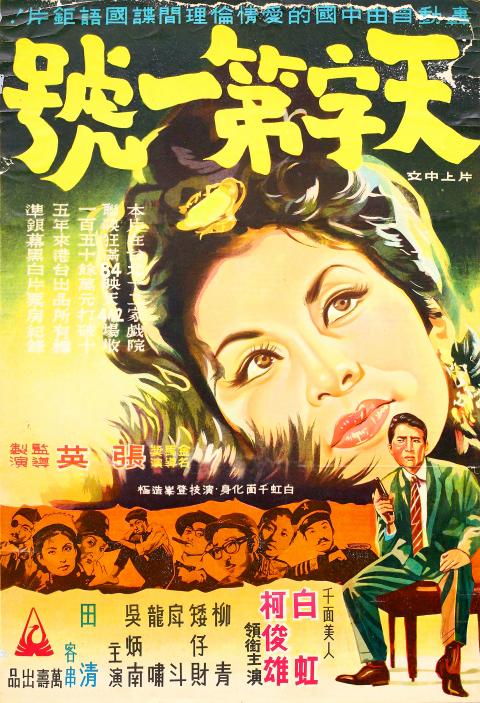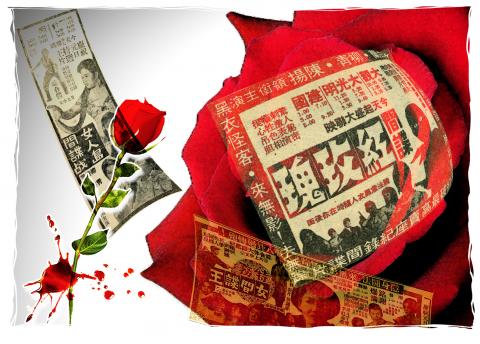The two existing film copies of The Best Secret Agent (天字第一號) were both in terrible condition. One was overexposed with significant damage in the highlight areas, while the other showed severe deterioration with scratches, stains, mold and flaky coating.
However, it was fortunate that the 1964 Hoklo-language (also known as Taiwanese) femme fatale flick was preserved at all. After the decline of the Hoklo film industry in the late 1970s, many directors sold their reels to scrap dealers, while the film strips ended up as linings for shirt collars, straw hats and wooden sandals. Countless more were lost to floods, fires and the ravages of time. When people started paying attention to these movies again in the 1990s, many had already been permanently lost.
Lee Cheng-liang (李政亮), assistant professor at National Chengchi University’s College of Communication, estimates that out of the more than 1,000 Hoklo films produced between 1956 and 1981, only about 200 remain.

Photo courtesy of Taiwan Film Institute
The Taiwan Film Institute (國家電影中心) has taken on the role of preserving, restoring and digitizing these films since 2013. What remains is still quite diverse in genre and style — many taken straight from Hollywood, resulting in curious and campy Taiwanese Westerns and spy movies often featuring female leads.
The restored version of The Best Secret Agent was screened at Enka Library (櫞?文庫) last weekend as part of a Taiwan Film Institute program to encourage coffee shops and other establishments to screen Taiwanese movies that they have digitized over the past few years. Three more femme fatale screenings are in store — the next one on Saturday is King of Spies: Female Secret Agent (特務女間諜王), which features a Chinese Nationalist Party (KMT) agent who heads to Macau to stop the Chinese Communist Party from smuggling in American missile blueprints.
THE GLORY DECADES

GRAPHIC: TT
In 2013, a team from Tainan National University of the Arts acquired a box of old films from a projectionist in Miaoli. After months of restoration, they discovered that one of them was the long-lost first 35mm Hoklo movie, Hsueh Ping-kui and Wang Pao-chuan (薛平貴與王寶釧).
Made in 1956, the film followed a traditional gezai opera (歌仔戲) format and launched the first Hoklo movie craze that lasted until about 1960. The iconic Brother Wang And Brother Liu Tour Taiwan (王哥柳哥遊台灣), clearly inspired by the US comedic duo Laurel and Hardy, was produced during this time.
The scene took off again in 1962, which saw 120 Hoklo movies made in that year alone. This number far exceeded that of Mandarin movies, despite the government’s policy to promote Mandarin and suppress local languages like Hoklo. The Golden Horse Awards were established that year specifically to “promote Mandarin movies,” and the number of Mandarin movies eventually surpassed Hoklo ones in 1969.
Lee says many of these films suffered from bad scripts and poor production, resulting in campy, B-movie qualities that make them entertaining to watch today. A common tactic was to feature popular singers in the film and rely on their star power to attract audiences, at times even having them appear at the premiere to perform a few tunes.
Most production companies preferred quantity over quality, usually renting a hotel in Taipei’s Beitou District (北投) and shooting the entire thing in a week. The area became sort of a “Hoklo Hollywood” during those decades.
“Those who were willing to spend half a month on their film were already considered very dedicated,” Lee says.
LOCAL AND FOREIGN
Lee separates Hoklo movies into local genres and “hybrid” genres that emulate Japanese and Hollywood themes. Popular local storylines include a young person from the countryside losing their way in the decadent “sin city” of Taipei, while their loved ones back home head to Taipei to search for them. Females often played tragic roles, whether a poor farm girl with unknown parentage, or the adopted daughter who was treated badly and eventually sold to a brothel.
Martial arts films were also popular — interestingly, 41 years before Crouching Tiger, Hidden Dragon (臥虎藏龍) took Hollywood by storm in 2000, a Hoklo version based on the novel of the same name had been made. This production has not been recovered.
“Hybrid” films include the aforementioned Brother Wang and Brother Liu series, wholesale adaptations of Japanese hits such as the Golden Demon, as well as Westerns and spy movies. Bond movies were especially popular due to the government’s anti-communist propaganda, and Hoklo filmmakers jumped on the bandwagon.
“The Hoklo film industry had few resources, but the producers reacted quickly to popular trends, often just remaking the entire movie,” Lee says.
The Best Secret Agent is a prime example of the hybridity Lee discusses, as it’s a remake of a Chinese movie of the same name, set in Japan-occupied Shanghai during World War II. The genre was so popular that even Brother Wang and Brother Liu had their own 007 spinoff.
The last Hoklo film of that era was made in 1981. Lee says the quality in general simply wasn’t that great, and as young people shunned speaking Hoklo under government policy, interest waned, with such movies considered tacky. With government support focused only on Mandarin-language productions, Lee says the Hoklo movie industry was never able to transition to color film, further cementing its demise.
The National Film Institute first put together a team in 1989 to track down these Hoklo directors and their productions. In two years, they managed to recover 11 films and screened them in Taipei to great fanfare.
Today, the institute continues its effort to bring these films back to the public. Out of the 25 old Taiwanese films it digitized last year, three of them were Hoklo productions.

On April 26, The Lancet published a letter from two doctors at Taichung-based China Medical University Hospital (CMUH) warning that “Taiwan’s Health Care System is on the Brink of Collapse.” The authors said that “Years of policy inaction and mismanagement of resources have led to the National Health Insurance system operating under unsustainable conditions.” The pushback was immediate. Errors in the paper were quickly identified and publicized, to discredit the authors (the hospital apologized). CNA reported that CMUH said the letter described Taiwan in 2021 as having 62 nurses per 10,000 people, when the correct number was 78 nurses per 10,000

As we live longer, our risk of cognitive impairment is increasing. How can we delay the onset of symptoms? Do we have to give up every indulgence or can small changes make a difference? We asked neurologists for tips on how to keep our brains healthy for life. TAKE CARE OF YOUR HEALTH “All of the sensible things that apply to bodily health apply to brain health,” says Suzanne O’Sullivan, a consultant in neurology at the National Hospital for Neurology and Neurosurgery in London, and the author of The Age of Diagnosis. “When you’re 20, you can get away with absolute

May 5 to May 11 What started out as friction between Taiwanese students at Taichung First High School and a Japanese head cook escalated dramatically over the first two weeks of May 1927. It began on April 30 when the cook’s wife knew that lotus starch used in that night’s dinner had rat feces in it, but failed to inform staff until the meal was already prepared. The students believed that her silence was intentional, and filed a complaint. The school’s Japanese administrators sided with the cook’s family, dismissing the students as troublemakers and clamping down on their freedoms — with

As Donald Trump’s executive order in March led to the shuttering of Voice of America (VOA) — the global broadcaster whose roots date back to the fight against Nazi propaganda — he quickly attracted support from figures not used to aligning themselves with any US administration. Trump had ordered the US Agency for Global Media, the federal agency that funds VOA and other groups promoting independent journalism overseas, to be “eliminated to the maximum extent consistent with applicable law.” The decision suddenly halted programming in 49 languages to more than 425 million people. In Moscow, Margarita Simonyan, the hardline editor-in-chief of the